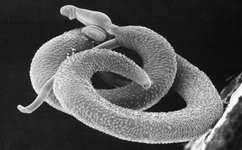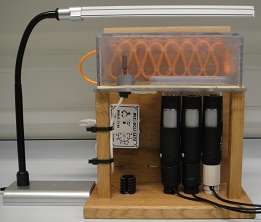Microscope hack could offer cheap disease testing

A new solution to measure cell movement could save scientists hundreds of thousands of pounds, says the researcher who developed the method to save himself time and money in the lab.
Cell motility - how fast cells move from one place to another - is used to test for a variety of things, from sperm fertility to disease diagnosis. But the methods used to test it are expensive, ranging from a few hundred pounds for a specific type of microscope slide, to hundreds of thousands for a top-of-the-range inverted microscope (which looks at the cells from beneath instead of above) capable of automatically testing multiple samples.
But now scientists from Brunel University have hacked a cheap microscope they bought online to produce similar images for a fraction of the cost.
As part of a study to understand how snails that may have the disease Schistosomiasis react to chemicals in water,the team needed an inverted microscope to see whether the cells moved towards or away from polluted water. But they needed more than one machine to be able to run the multiple tests needed.
'When you're looking at motility in cells you're only interested in the data – how fast the cell gets from A to B means more than a high-resolution image. Even with a high-cost microscope you will reduce the image down so that it's just a black dot on the screen moving against a white background so that it's easier for a computer to read,' explains PhD student Adam Lynch of Brunel University, who pioneered the new technique.

Lynch realised a USB microscope he'd bought online could be clamped upside down on a table to produce the same images as the much more expensive inverted microscope.
'It worked ok as I could sort of see cells, which are about 50 micrometres long, but the images weren't fantastic,' he says. 'But people don't realise that you can quite easily make a high-magnification microscope, it's just a matter of getting a lens and the right angle of lighting, so when I turned off the lighting that came with the instrument and used external lights I found I could see the cells quite clearly.'
The next problem Lynch faced was scaling it up, to run multiple sets of cells at once, exposing different cells to different chemicals. He bought three cheap microscopes and put them together and multiplied his output by three - something the university couldn't have afforded with the inverted microscopes.
Lynch struggled to get the computer software which collected the images to respond to three identical instruments at once. Asking for advice on a coding forum online he came across Junian Triajinto. Instead of just offering Lynch a workaround, Triajinto wrote software that would enable the microscopes to allow Lynch to run three microscopes at once from a single laptop. The team called the final system, LOCOMOTIS, short for the Low-Cost Motility Tracking System.
'I could have worked around the software but one alternative would be to have three laptops, which is very convoluted, it's not an elegant solution. The software let me use one laptop with three cameras, and since these microscopes are coming down in price all the time, the whole thing cost about £100,' Lynch says.
'If money is no object you can do something better but money certainly is an object and really the only way we can get meaningful data without spending a disproportionate amount of time in the lab was this,' says Lynch.
The next step for the technology is to build a more attractive case, and to look for other real-world applications. Lynch hopes it will be particularly useful for scientists to study cell-motility in the field, specifically on species which don't transport well.
But portability isn't the only benefit. By keeping costs down, and by needing just one laptop to run, Lynch hopes his solution will help developing countries to study Schistosomiasis, and test for it in rivers that people drink from.
'The irony is that these diseases are in the places with the lowest resources. They might not have labs with equipment and inverted microscopes, but people do have laptops. We checked this doesn't need the top of the range stuff to run, it's pretty simple stuff. But people could make use of a low-cost system compatible with basic technology,' he says.
More information: Lynch AE, Triajianto J, Routledge E (2014) Low-Cost Motility Tracking System (LOCOMOTIS) for Time-Lapse Microscopy Applications and Cell Visualisation. PLoS ONE 9(8): e103547. DOI: 10.1371/journal.pone.0103547
Journal information: PLoS ONE
Provided by PlanetEarth Online
This story is republished courtesy of Planet Earth online, a free, companion website to the award-winning magazine Planet Earth published and funded by the Natural Environment Research Council (NERC).


















